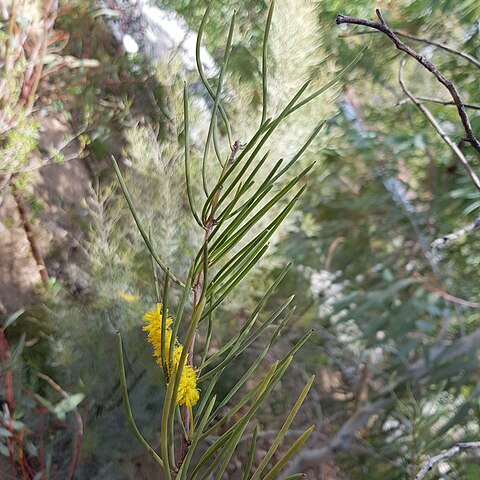Shrub or tree to 4 m high, 3-5 m wide, multistemmed or branching low to ground, flat-topped, resinous. Bark 'Minni Ritchi', red-brown. Branchlets very slightly angular towards apices, soon terete, orange, grey or light brown, glabrous or puberulous between orange ridges, often papillose. Phyllodes ±erect, thickly filiform, ±straight or often curved towards base, terete or subterete, (3-) 4-7 (-9) cm long, rarely longer, 1-1.5 mm wide, coarsely pungent, rigid, finely multistriate; nerves translucent, puberulous, 8-10 per mm; gland 1, small, basal, to 3 mm above pulvinus. Spikes 0.8-3 cm long, golden. Flowers 5-merous (rarely 6-merous flowers amongst mostly 5-merous flowers on same spike); calyx 1.1-1.5 mm long, dissected for 1/5-1/2, ±pubescent; corolla 1.6-2.4 mm long, dissected for 1/3-1/2, with papillose margin; ovary glabrous or slightly hairy. Pods linear, slightly constricted between seeds, straight or falcate, 6-11 cm long, subwoody, at maturity transversely cracked, minutely puberulous; margins slightly thickened. Seeds longitudinal, rotund or orbicular, flattened, depressed towards centre, 6.5-9 mm long, brownish black; pleurogram raised, with narrow halo; areole open, c. 1-1.2 mm long, yellowish olive.
More
A spreading shrub. It can be 3-4 m tall and 3-4 m across. The bark is brown and peals off in curly flakes. The leaves (phyllodes) are 4-5 cm long and round in cross section. They are covered in short hairs. The flowers are like rods 2 cm long. They are carried on their own and are yellow. They are on a 2 cm long stalk. The pods are 8-11 cm long by 1 cm across and straight or curved. They are flattened and constricted between the seeds.


